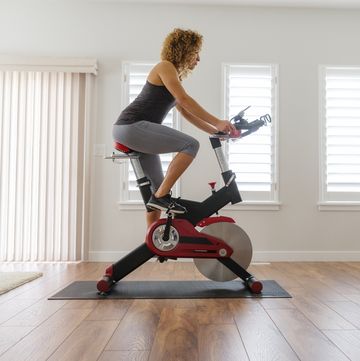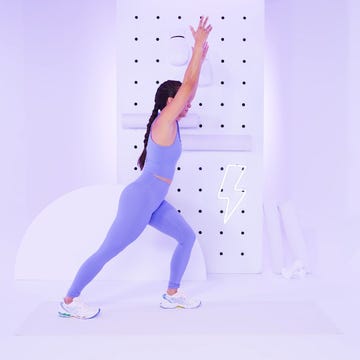Think about how you feel on the treadmill versus during a high-intensity interval workout: Your probably feel like you could maintain that steady state for a pretty solid amount of time without wheezing, while just one round of HIIT leaves you gasping for breath.
That difference is important to understand, because it's how you can tell aerobic vs. anaerobic workouts apart. Your body creates energy in two basic ways: anaerobically (without oxygen) and aerobically (with oxygen), and each of those methods will affect your body differently. Understanding that process can help you burn calories and fat—plus increase your overall strength, power, and endurance.
What’s An Anaerobic Workout?
Any activity performed at a high enough intensity that your body can’t provide the necessary energy to complete it with oxygen intake alone is considered anaerobic. “Anaerobic workouts primarily utilize fast twitch muscle fibers that can function only for a short amount of time without the help of additional inhaled oxygen,” explains Lesley Bell, a NASM-certified personal trainer and brain health coach at Pacific Neuroscience Institute at Providence Saint John’s Health Center in Santa Monica, Cali.
[pullquote align='left']"Anaerobic workouts primarily utilize fast-twitch muscle fibers."[/pullquote]
Without oxygen, the body uses adenosine triphosphate (ATP) and glucose in the muscle cells for energy. But that process can’t be sustained more than 90 to 120 seconds of high-intensity exercise because your muscles have produced a significant amount of lactic acid in that time; after that, “your body must begin to utilize inhaled oxygen in order to break down glucose and fatty acids” to continue to produce energy, says Bell, and that’s when your aerobic energy system takes over (more on that in a minute).
Here's an advanced HIIT workout from Kelsey Wells that'll get your heart pumping:
“Anaerobic is done at a high intensity and usually using multiple intervals,” says Andy Coggan, the director of fitness at Gold’s Gym. If you’ve ever done a HIIT workout, that’s anaerobic exercise. Plyometrics, sprinting, and weight lifting are all considered anaerobic—you’re going all out with 100-percent effort, but you can only sustain that effort for a short period of time. “Most sports involve anaerobic bursts followed by periods of rest,” too, he adds.
What’s An Aerobic Workout?
If the word “aerobics” makes you think of women dancing in Spandex, you’re on the right track—those low-intensity classes are designed to keep your heart rate up for an extended period of time.
“Aerobic exercise is anything where oxygen intake is sufficient enough to provide the energy necessary to sustain that exercise without tapping into alternative energy sources,” says Coggan. These workouts primarily utilize slow twitch muscle fibers and the glucose and fatty acids the anaerobic system has already produced for fuel, which can sustain activity for extended periods of time, adds Bell.
Any lower- to moderate-intensity exercise is considered aerobic. Think about steady-state exercise like walking, running, cycling, or even dancing. You’re not going to be gasping for breath during these workouts, because your body is continuously consuming enough oxygen for you to power through.
Why Are Aerobic and Anaerobic Workouts Important?
Obviously, these styles of training are pretty different. And they’re both equally important in a well-rounded fitness regimen.
Aerobic exercise triggers fat burning, because you still have oxygen in your muscle tissue. It also “improves the cardiovascular system by strengthening the heart and potentially increasing the maximal amount of oxygen the body can utilize (AKA your VO2 max),” says Bell, which can improve your endurance.
On the other hand, anaerobic exercise—like HIIT—has been shown to burn more total calories in a shorter amount of time. “Science shows that this method of training can be extremely beneficial for power development, building muscle mass, and fat burning,” says Coggan. You’ll also build stronger joints and bones due to the increased impact on your body.
To picture how these training methods affect your body, think about the bodies of elite athletes: A typical cross-country runner or marathoner follows a highly aerobic training program, whereas a CrossFitter is someone who prioritizes an anaerobic program.
But you can’t just do cardio or just do weights if you want to get fitter or stronger—even if you have a specific goal in one of those areas.
“Both styles of training will burn calories and improve the function of the heart and lungs, and the best bet for maximum adaptation and body transformation is to combine these training styles over the course of a week,” says Coggan.
“In doing so, you’re getting the power- and muscle-building benefits of anaerobic work while adding the increased stamina and endurance associated with aerobic workouts.”
Here’s How Often You Should Be Doing Aerobic and Anaerobic Exercises Per Week
As Coggan said, you want to make time for both anaerobic and aerobic workouts throughout your week. The most important thing to remember is that there’s an inverse relationship between intensity and duration, says Bell. That means you want to do less of the higher intensity workouts (anaerobic) and more of the low- to moderate-intensity workouts (aerobic).
“Research has shown that a maximum of three to four days of high-intensity exercise with proper rest periods in between is optimal to see results,” says Bell.
“Anything more may yield the same or similar health benefits, but can put you at risk for overtraining or overuse injuries.”
Aerobic exercise, though, could theoretically be done as many as seven days a week. The U.S. Department of Health and Human Services recommends adults have at least 150 minutes of moderate intensity cardio per week. “You could split that up anywhere between two to five days, as long as you’re keeping your heart rate around 60 to 75 percent of your maximum,” says Bell. (If you’re going to increase the intensity of the cardio, you’ll want to decrease the duration of it.)
The average person should start with one to two aerobic sessions with one anaerobic session per week, says Coggan. “Over time, you can work up to three to four aerobic sessions intermixed with two higher intensity anaerobic workouts spaced a few days apart from each other,” he says.














